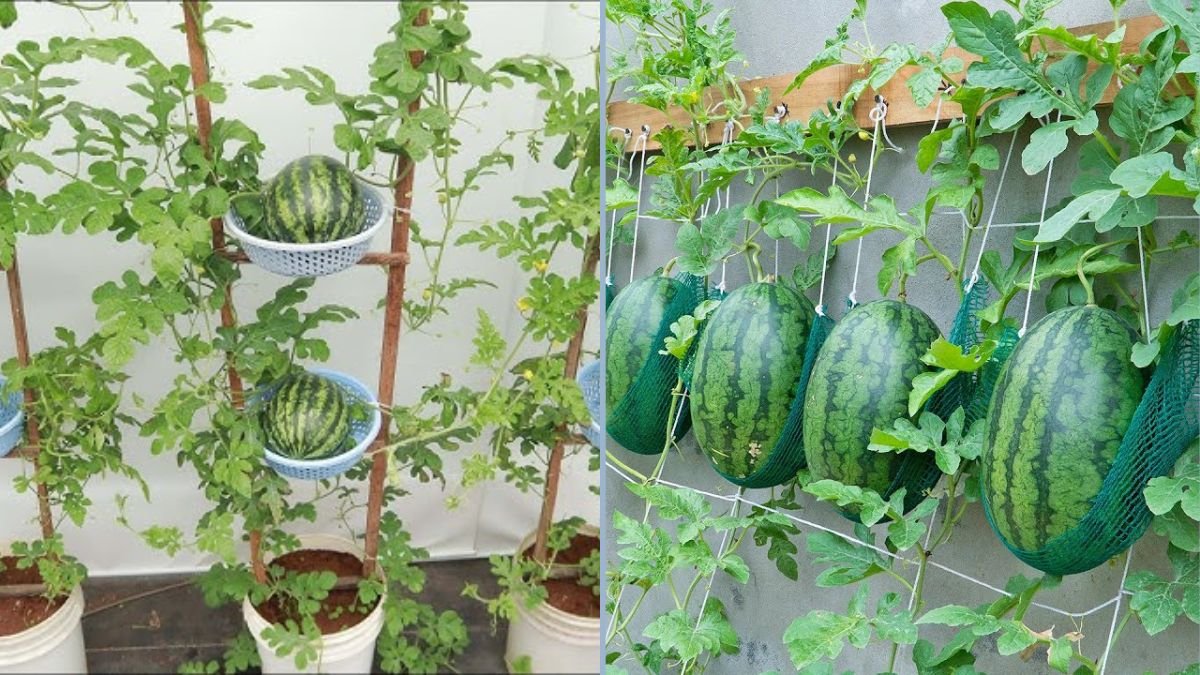Watermelons are one of the most refreshing and beloved fruits during the summer. Sweet, juicy, and packed with nutrients, they are a favorite in salads, smoothies, and simply enjoyed on a hot day. However, growing watermelons at home can seem intimidating because of their large size and sprawling vines. But what if we told you there’s a way to grow watermelons in limited space, even vertically, using a hanging hammock technique? In this guide, we will take you through everything you need to know to successfully grow watermelons at home using a hanging hammock.
Why Grow Watermelons at Home?
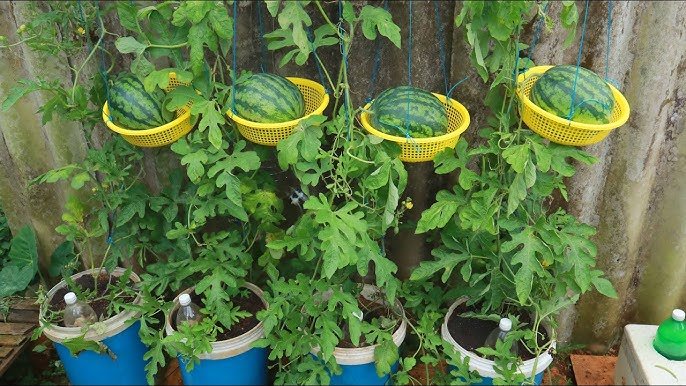
Growing watermelons at home offers several benefits:
- Freshness and Flavor: Homegrown watermelons often taste sweeter and juicier than store-bought ones.
- Pesticide Control: You have full control over what goes into your garden.
- Space Efficiency: Using creative methods like a hanging hammock allows you to grow watermelons even in small spaces.
- Satisfaction: Watching a watermelon grow from seed to a full fruit is incredibly rewarding.
Understanding the Hanging Hammock Technique
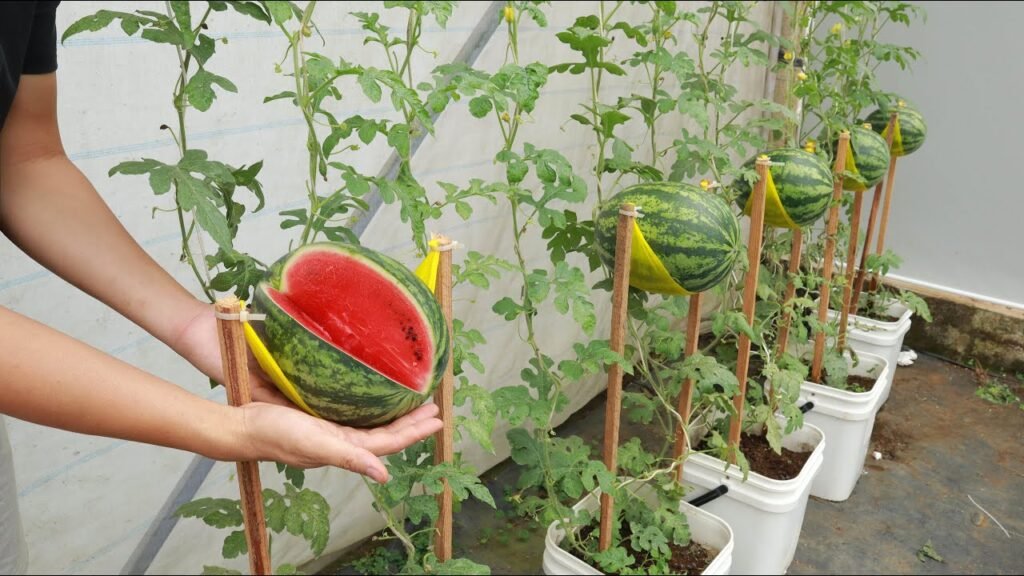
The hanging hammock technique is a clever solution for supporting heavy watermelons as they grow. Watermelons can become extremely heavy, and if left unsupported, the vines may break or the fruit may fall off prematurely. A hanging hammock cradles the fruit, providing support while allowing the vine to continue growing naturally.
Benefits of the Hanging Hammock:
- Prevents the watermelon from touching the soil, reducing the risk of rot.
- Reduces pest attacks from ground-dwelling insects.
- Allows vertical growth, ideal for small gardens, balconies, or even greenhouses.
Materials Needed
Before you start, make sure you have the following materials:
- Watermelon seeds or seedlings
- Fertile soil and compost
- A strong trellis or vertical support system
- Fabric or mesh for making the hammock
- Soft string or rope
- Watering can or irrigation system
Optional: Mulch for moisture retention and organic fertilizer for better growth.
Step 1: Choosing the Right Watermelon Variety
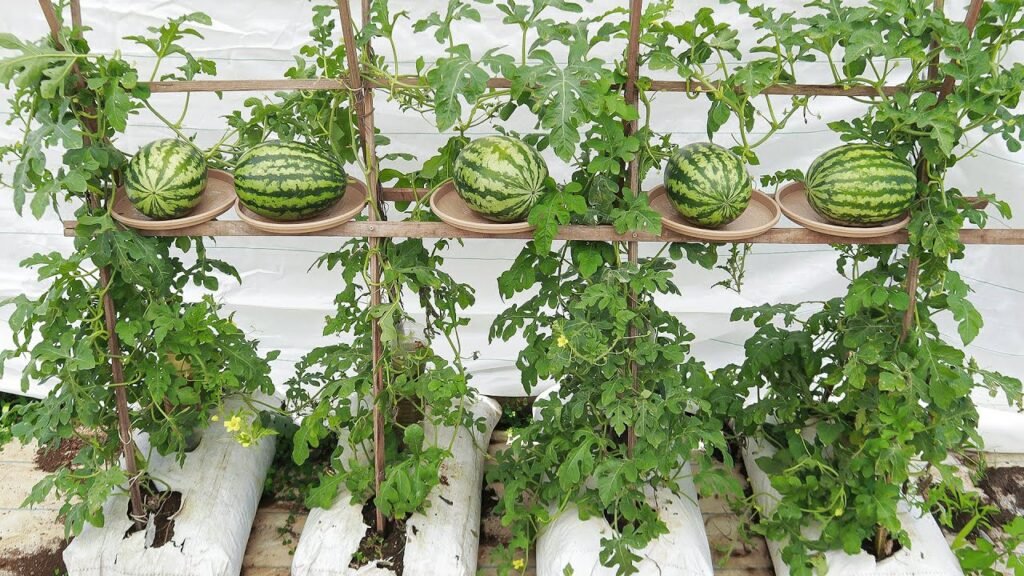
Not all watermelons are suitable for growing in hammocks. Small to medium-sized varieties work best for vertical growth. Some recommended varieties include:
- Sugar Baby
- Golden Midget
- Petite Sweet
- Small Crimson Sweet
These varieties are compact, grow quickly, and are lighter, making them easier to support in a hammock.
Step 2: Preparing Your Growing Area
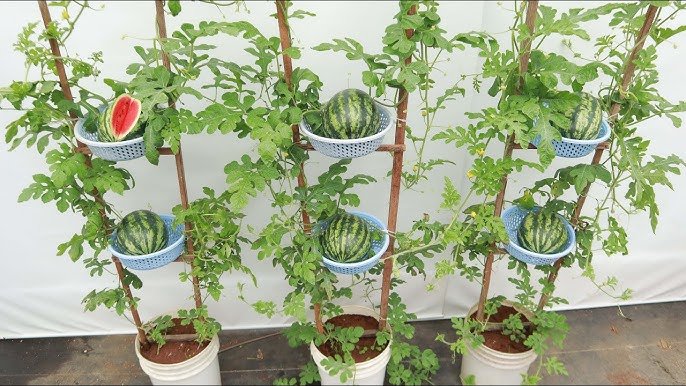
Choose a sunny spot in your garden or balcony. Watermelons need at least 6-8 hours of sunlight per day to thrive. Prepare your soil by mixing compost and organic fertilizer to ensure it is fertile and drains well.
Tip: If you are using a container, choose a large pot (at least 18-24 inches in diameter) with proper drainage holes.
Step 3: Planting the Seeds or Seedlings
Plant watermelon seeds about 1 inch deep in soil. Space seeds about 2-3 feet apart to allow for vine growth. If you’re using seedlings, transplant them carefully to avoid disturbing the roots.
Water immediately after planting and keep the soil consistently moist. Avoid overwatering, as watermelon roots are prone to rot if waterlogged.
Step 4: Setting Up the Trellis and Hammocks
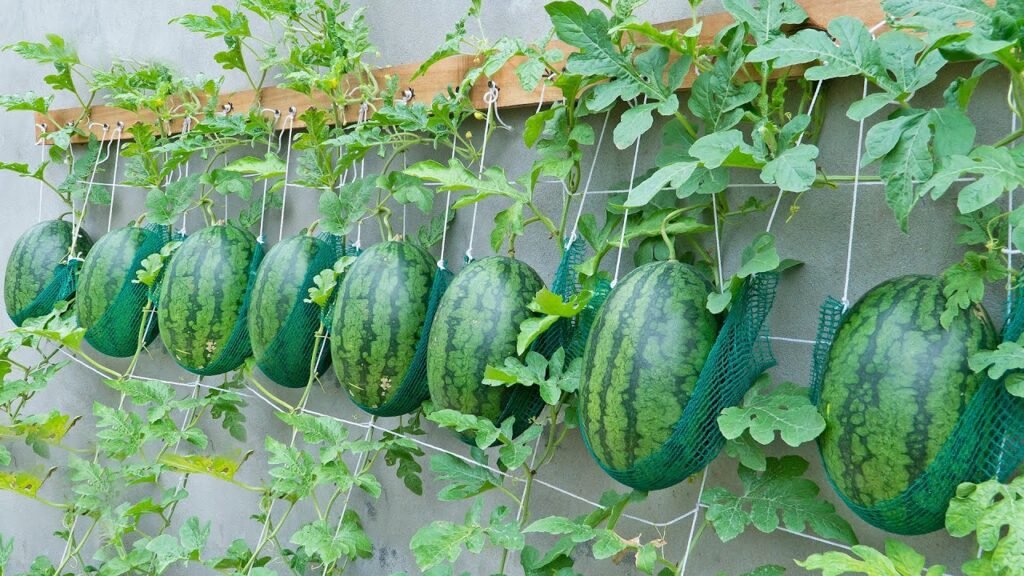
Once your watermelon vines start growing and you see small fruits forming, it’s time to set up support.
Steps to Make a Hanging Hammock:
- Cut a square piece of soft, breathable fabric or mesh.
- Place the small watermelon fruit in the center.
- Gently gather the corners of the fabric and tie them securely with soft string to your trellis or overhead support.
- Ensure the hammock holds the fruit snugly without squeezing it.
Tip: Check the hammock daily to ensure the fruit is secure and not rubbing against the edges.
Step 5: Watering and Feeding Your Watermelons
Watermelons are heavy feeders and need consistent moisture for optimal growth. Water deeply once or twice a week, depending on weather conditions. Avoid wetting the leaves to prevent fungal infections.
Fertilize every 2-3 weeks using a balanced organic fertilizer. Once fruits start forming, switch to a fertilizer higher in potassium to encourage sweetness and size.
Step 6: Pruning and Training Vines
Watermelon vines grow rapidly and can become tangled. Regularly prune excess leaves and side shoots to direct the plant’s energy toward fruit production.
Train the vines to climb the trellis and avoid overcrowding. Use soft ties to gently secure the vines to the trellis. This not only supports growth but also improves air circulation, reducing disease risk.
Step 7: Protecting Fruits from Pests and Diseases
Even in a hammock, watermelons are susceptible to pests such as aphids, beetles, and fruit flies. Organic solutions include:
- Neem oil sprays
- Insecticidal soap
- Row covers for young fruits
For diseases like powdery mildew or fusarium wilt, ensure proper spacing and airflow. Mulching around the base can also prevent soil-borne diseases.
Step 8: Harvesting Your Watermelon
Patience is key. Watermelons typically take 70-90 days to mature, depending on the variety. Signs of ripeness include:
- The tendril closest to the fruit turns brown and dries up
- The underside of the watermelon turns from green to a yellowish hue
- The skin becomes firm and resists indentation
Cut the watermelon from the vine using a sharp knife, leaving a short stem attached. Avoid pulling, as this can damage the vine or fruit.
Step 9: Enjoying Your Homegrown Watermelon
There’s nothing quite like the taste of a homegrown watermelon. Chill it for a refreshing summer treat, use it in fruit salads, or blend it into smoothies. Growing your own fruit also allows you to experiment with unique varieties that may not be available in local stores.
Tips for Success
- Start Small: If you’re a beginner, grow one or two watermelons first.
- Monitor Weight: Make sure your hammock and trellis can handle the growing fruit’s weight.
- Consistent Care: Regular watering, fertilizing, and pruning are crucial for healthy plants.
- Rotate Crops: Avoid planting watermelons in the same soil year after year to reduce disease risk.
- Sunlight is Key: Ensure your plants get at least 6-8 hours of direct sunlight daily.
Conclusion
Growing watermelons at home using a hanging hammock is a fun, efficient, and rewarding method, especially for gardeners with limited space. By carefully selecting the right variety, providing proper support, and maintaining consistent care, you can enjoy sweet, juicy watermelons straight from your garden.
Not only does this method save space and prevent fruit rot, but it also adds a creative and visually appealing touch to your garden. Whether you have a backyard, balcony, or rooftop garden, this vertical gardening technique can transform how you grow watermelons at home.
With patience, attention, and a little love for your plants, you can enjoy the satisfaction of harvesting your very own homegrown watermelons and sharing the joy with family and friends.
